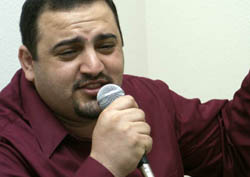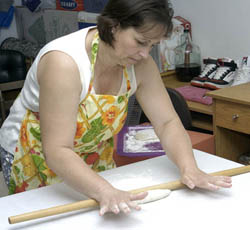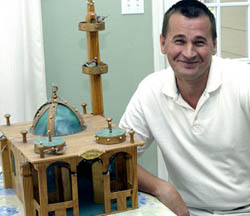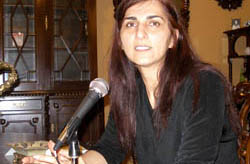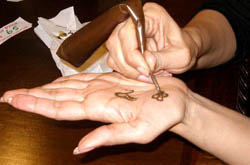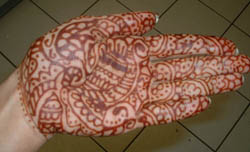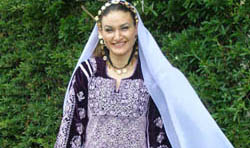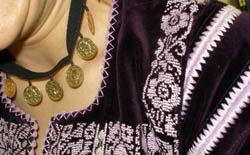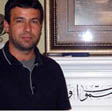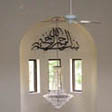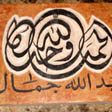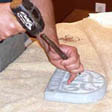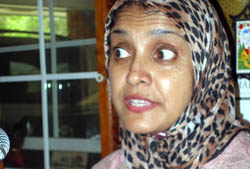Places Called Home: Folk Traditions among Muslim Immigrants in Baton Rouge, Louisiana
By Jocelyn Hazelwood Donlon
The notion of "home" is a moveable feast for any person who has pulled up roots and relocated to a new and unfamiliar place, whether that person has moved from Mamou to Shreveport, or from the Middle East to Baton Rouge. For most any member of a "new population," home is about looking backwards to cherish the familiar, painful or pleasurable, while also facing forward to create new opportunities. It is not surprising, then, that from their home countries and communities, the Muslim immigrants of Baton Rouge have transported and adapted their venerated folk traditions to practice in their new home.
Among the many Muslim immigrants of Baton Rouge, seven individuals from Palestine, Pakistan, Bosnia, and Mauritius agreed to share their stories in March, 2007, for the New Populations Project. These seven people provide a window into the much larger Muslim population of Baton Rouge. According to the 2000 census, 2,793 people of the total 412,852 residents in East Baton Rouge Parish, reported having been born in foreign nations with a majority Muslim population. It is impossible to know how many of these people were United States citizens born abroad, or how many were-and are-practicing Muslims. But these figures give us a rough idea of the substantial size of the Muslim community in Baton Rouge, one that has come from around the globe to seek new and different opportunities. Some people have immigrated permanently to become citizens. Others have relocated temporarily for educational or work opportunities. Still others have come as refugees, hoping to escape political violence and even war. Whatever their motivation, many Muslim immigrants, representing such countries as Bosnia, Egypt, Indonesia, Jordan, Lebanon, Nigeria, Pakistan, the Palestinian territories, Turkey, and others, have brought a sense of "home country" to Baton Rouge.
Home Matters
The folk traditions of the seven individuals represented here reveal various ways in which Muslim immigrants sustain connections to their home country, while also negotiating, through their everyday practices, a new cultural identity in Baton Rouge. Moreover, these practices, undertaken in both public and domestic spaces and along religious and secular lines, reveal diverse cultural cross-pollinations. Despite such diversity, the significance of home, family, community, and faith shapes each participant's story, albeit in different ways.
Oaf Music
Nizar Tayem, who moved from Palestine to the United States in 2001, has adapted traditional Palestinian Oaf singing to his new cultural setting. Oaf music, traditionally sung by men (females do not sing it), is sung to communicate themes of love, longing, and devotion. The songs that Nizar performed are about one's longing for a family far away, about helping loved ones to carry their burdens, and about birds singing a person to sleep. The songs, themselves, give voice to nostalgia for homes departed.
When Nizar sings, he closes his eyes, moves his left hand in the air to help him keep time, and sings with no instruments. He begins with a long "Ooooooffff" sound-giving the name Oaf to the music, and then launches into the song. Nizar says that "it's better for performance to have an instrument," such as the oud , a stringed instrument similar to a lute, but he uses no instrument other than his voice. Oaf singers choose their songs to suit the occasion. For example, if a person is far from home, he might sing something about being nostalgic for family and country. The lyrics are quite serious and meaningful, and sung out of respect. Nizar loosely translated one of his songs in the following words:
A girl goes to some land, and she is carrying a heavy water vessel. The singer asks God to help her carry it because it is so heavy. He asks the girl not to carry it because it is too heavy for her. If the air needs to help her, he'll ask the air to contribute.
In essence, the song tells of man's appeal to God and nature to help his far-away loved one to carry her daily burdens.
By its very nature, Oaf music is intended for public consumption-to be performed at weddings and parties. Some people "back home" may even hire a zajjallen , a professional singer who wears traditional Palestinian dress and is paid for the performance. There are indeed rare occasions in the United States where Nizar has performed publicly. When he does so, it is as a special tribute to close family and friends. He sang Oaf music for Shereen, his wife, at his own wedding reception (held in North Carolina), as well as at another wedding of a close friend, also in the United States, Nizar's primary use of Oaf music is not, however, for public consumption; instead, he mostly performs his music in his home for Shereen (who finds the singing romantic), his infant son, Laith, and his close friends. At only six months old, Laith was already making an "Oooo" sound when Nizar launched into the music.
Oaf music is secular in nature, so even if Nizar attended the mosque in Baton Rouge, it is doubtful that he would perform his songs in a religious setting. Nevertheless, Nizar and Shereen do not attend the mosque, though they are very devout. Shereen voluntarily wears the headscarf, the couple fast during Ramadan, and they celebrate the traditional "Eid" holidays. (The term "Eid" is used to signify the two most important religious celebrations for Muslims. Eid ul-Fitr marks the end of Ramadan, the month of fasting meant to help individuals achieve a greater sense of discipline and compassion. The second "Eid" holiday is Eid ul-Adha , the annual "sacrifice holiday" during which an animal is ritually slaughtered to feed family, friends, and the poor.)
Nizar and Shereen practice their religious traditions, but, while in the United States, their primary commitment is to their own nuclear family rather than to a larger religious community. Before marriage, Nizar, then a Ph.D. student in Wichita, Kansas, did spend much time at a mosque, to feel a sense of religious community and to socialize with his male friends. In Baton Rouge, his focus has turned to work and family. If the family decides to remain in the United States, the tradition of Oaf singing will likely remain an intimate one with this family, practiced within the home, determined by opportunities and priorities. But the songs themselves will inevitably take them back to their home country and public celebrations.
Bosnian Pita Bread
The same sense of family devotion accounts for the folk traditions of Hasan and Emira Stranjac, immigrants from Bosnia who arrived in Baton Rouge in the year 2000. "Refugee" is a more accurate word for Hasan and Emira, who left Bosnia during the War in Bosnia and Herzegovina. Had their home country remained stable, they would likely never have left. To immigrate, they were forced to take a step down from their more professional jobs in Bosnia: whereas Hasan was a policeman and Emira a secretary in Bosnia, they accepted custodial work in the United States to support their family. While providing new opportunities for their now young-adult children has governed their choices in the United States, they have also worked to keep their Bosnian heritage alive within their home.
Emira's traditional cooking is one way in which the nuclear family has maintained not only family unity but also home connections to Bosnia. Her specialty is Bosnian pita bread, which she makes for her family once or twice most weeks. She has also taught her daughter, now attending university out of state, and her son's American girlfriend to make Bosnian pita. In her new home, where she takes comfort in knowing that her children have increased opportunities, she routinely connects them to where they came from through her cooking.
By all accounts, Emira's pita-making skills are exceptional. Hasan boasts about her special ability to roll pita dough so thin (resembling sheets of phyllo dough) that she can cover the entire top of a card table. Many of her friends say that it is "too hard" to roll the dough this thin, but it is no challenge for Emira, who keeps a card table standing in her garage, always at the ready for pita-making.
As was the case with Emira's mother, pita bread needs to have a substantial filling because it is traditionally made to feed large families. For ingredients, Emira uses flour, Vegeta (a spice which she buys at a local international shop and smells like bouillon) vegetable oil, onion, black pepper, salt, and water. Her tools consist of an ordinary kitchen knife, three differently-sized round pans, all of which are called tepsija, and a long, thin rolling pin—which looks like a dowel—called an oklagia. For meat-stuffed pita bread, she uses ground beef, chicken, turkey, veal, or lamb. As was the case with Emira's mother, pita bread needs to have a substantial filling because it is traditionally made to feed large families. Sometimes Emira freezes the pita bread, but Hasan observes that in Bosnia it is always made fresh because "people are not so busy" and because the freezers are much smaller. Cheese pita is her son's favorite, so she bought a special small pie pan just for him.
Hasan notes that, in his generation, "She who wants to be married must do pita." Emira added that even though her daughter does know how to make pita, it is "because she wants to eat it," not because she is trying to win a husband. The daughter, according to Emira, is "an American girl," and the tradition of pita-making has inevitably adapted to a contemporary American setting as it is transmitted from mother to daughter. Nevertheless, Emira has kept her family connected to their homeland through her traditional and exceptional cooking.
Miniature Mosque
Hasan has also done his part to maintain a sense of Bosnia in his Baton Rouge home. In 2001, for the simple pleasure of his family, he fabricated a miniature mosque out of everyday materials. He was motivated by seeing a Christian nativity scene displayed, and he told himself that he must do something similar for Islam. The family of four had just arrived in the United States as refugees, with few-to-no personal possessions. Because he had none of his tools to work with, he used kitchen knives and whatever else he could find to make his mosque.
Hasan combed Baton Rouge to locate his materials. He bought paneling wood at a supply house to fabricate the exterior walls of the mosque. He also used prefabricated items, such as sheets of green plastic, cut in an arch-shape to serve as windows; cabinet liners for interior floor covering; miniature dolls to represent the Imam and worshippers (the Imam mounts the pulpit steps to give a sermon) and doll furniture; a miniature book for the Koran; a bookstand made of balsa wood to hold the Koran; and yellow Christmas lights for indoor lighting (he bought multi-colored lights and removed all the colored ones to replace with yellow for more accuracy). He used black paint and a small paint brush to draw calligraphy on the inside of the mosque (copying Arabic from a book) to represent the names of Allah and the prophet Mohammed. And he made a hidden door on the stairs for the Imam to enter the minaret to sing the call to prayer. On the exterior of the mosque, Hasan used gold Mardi Gras beads for decoration on the dome and minaret; drawer pulls for architectural detail on the roof. The minaret is fabricated out of cardboard paper towel tubes, the top of a flag pole forming its peak, and decorated with perching miniature birds.
Examples of cultural cross-pollinations in the construction of the mosque are found in the yellow Christmas lights for indoor lighting and in the gold Mardi Gras beads for decoration on the dome and minaret. Using materials dedicated to two Christian holidays on a mosque which was inspired by a Christmas nativity scene demonstrates the porous nature of folk traditions when they get re-located to a different cultural space.
Perhaps the most revealing detail is the painted script over the mosque's entrance: Hasan Begova DžAmija . In the Bosnian language, " DžAmija " means "mosque," and a " begova " signifies the leader of a district (similar to "mayor"). So the entryway reads something akin to "Mayor Hasan's Mosque." This whimsical detail places the mosque at the heart of Hasan and Emira's domestic, private life rather than at the center of a larger Muslim community. Indeed, primarily because of language barriers, Hasan and Emira do not attend the mosque in Baton Rouge. The dominant languages at the mosque are Arabic and English, and Hasan and Emira are not comfortable socializing with large English-speaking groups. They do not want to go to the mosque simply for prayer, without being able to socialize. Such a decision demonstrates that the community mosque functions as much more than a prayer hall for Baton Rouge's Islamic population. It is a social center as well as a place of prayer, connecting families to a larger community.
Community Practices
All of the people interviewed remain committed to practicing Islam in Baton Rouge, which is a rather conservative, predominantly Christian city. They continue to celebrate the Eid holidays with family and friends, most of them fast during Ramadan, and many of them pray five times a day, at home, work, or at the mosque. Certainly faithful attendance at a mosque is one way to practice devotion to Islam. But it is, of course, not the only way. Local devout Muslims who do not attend the mosque cite different reasons for their choices.
One participant, Misbah Majeed, does not attend the local mosque because she and her family practice self-study of the Qur'an. Misbah and her husband, Tahir, who owns a shop that sells reproductions of antique furniture, were born in Pakistan. Misbah came to the United States in 1991; Tahir, in 1982. The family moved to Baton Rouge from Houston in 1997 because they like the green spaces and the slower pace of a smaller city. They and their two children call themselves "submitters" in English, noting that the word "Muslim" means "submitter." Within their home, they devote time to reading and studying the Qur'an, in Arabic, for themselves. Misbah says that she does not want to "feel guilty" about having depended on someone else's interpretation of the Qur'an when she stands "in front of God" after death.
Islamic Beauty And Henna Art
Based on her interpretation of the Qur'an's instructions, Misbah, who owns and operates "Salon Misbah" in Baton Rouge, restricts her business to women only, taking seriously the Qur'an's prohibitions against intimacy with unfamiliar men. She does not, however, wear the headscarf, noting that the Qur'an never explicitly mentions covering the hair. She says that the Qur'an instructs women to "lengthen your dress, cover your chest, and lower your eyes." She laughs and says, "My eleven-year-old daughter can tell you what a decent dress is," believing that modesty is common sense, but that head-covering is, quite literally, a "man"-made thing.
Thus, Misbah negotiates her private religious study, occurring in the domestic world of family, with her public business. Because she restricts her salon to women only, many Muslim women who do wear the headscarf seek her out. She says, "They find it a blessing that they can come here and it's just them and me. No men are going to come."
Among her many services, Misbah creates henna art on women's bodies, primarily for weddings, trading in cultural traditions from Pakistan. Having learned from her mother and grandmother at home, she now serves a multi-national population at Salon Misbah in Baton Rouge, resulting in diverse cross-pollinations of culture. She serves "Arabs, African Americans, Taiwanese, Vietnamese, Indians, Pakistani, Americans," to name only some of the cultural groups that frequent her salon. She recounts how "an American family, whose daughter was getting engaged, wanted henna done to every guest." Some parents bring their teenage girls into the salon for temporary henna tattoos, in order to mollify their desire to get a permanent tattoo. She says that she has decorated the necks and wrists of "young girls and moms, too." She has decorated young girls from 3-14 years, and moms up to 60-70 years of age.
Women who want to be decorated for their wedding usually go to Salon Misbah the night before the wedding, or even two days prior. According to Misbah, "Henna takes two days to get the real color out." She advises her clients to put lemon and olive oil (or any kind of oil) mixed together and to keep rubbing it into the henna. Henna has metallic dyes in it, so the lemon and oil react to bring the color out. Henna is also very drying, so the oil hydrates the skin.
According to Misbah, a bride does not really consider her entire attire when choosing the henna design for her wedding. Henna is considered a "romantic thing" between a husband and wife. Also, according to tradition, a new bride does not have to do any work, after going to her in-laws after marriage, until her henna has completely faded. She is a "new bride." A Pakistani folk saying is that "the richer your color is, the more your husband loves you," sparing you the work. The more intricate, heavier the pattern is, the longer it will last. Misbah says that a current trend is to decorate arms and legs, as well as the hands. Nail coloring with henna, which is permanent, is also part of the design.
Henna is also used for religious celebrations. Sometimes, people go to Salon Misbah to decorate their skin for Eid. On the last day of Ramadan, some Muslims in Baton Rouge will have a "moon night," where women wear bangles and decorate with henna to celebrate. People also do this in Pakistan.
Misbah sees very little difference between Pakistani and Indian designs. She believes the Pakistani is more floral, less heavy, and very elegant. Indian designs are very intricate and heavier. She prefers a lighter, more delicate design because, when the henna is washed off, an intricate, heavy pattern is too hard to see clearly. She also believes that Arab designs are more geometrical, mixed with floral, and that Arab women do their arms, wrists, legs, and hands-covering more of the skin. According to Misbah, the designs can possibly have symbolic value, but not usually.
Misbah offers a full slate of services in her salon, though she, herself, creates a somewhat modest appearance with long, straight hair, conservative clothing, and natural make-up. While she will decorate her own and others' skin with henna, she will not use any on a woman's hair because it is too damaging, contrary to popular belief. The cosmetics that she markets in her salon are of a natural beeswax base and natural oils. Misbah, herself, doesn't use henna much because her skin really absorbs it, and she doesn't like to decorate her body too much. She doesn't wear jewelry or much makeup, preferring a natural look. Thus, Misbah has created a space where she can fashion for others a sense of beauty, grounded in non-western and western aesthetics, while practicing her own Islamic sense of modesty and moderation.
Palestinian Cross Stitching
Like Misbah, Inas Nazzal, a Palestinian living in Baton Rouge with her husband, Munir, and her two-year-old daughter, Sarah, has also taken her Islamic identity and aesthetics into the public workplace. Inas teaches fine arts at the Brighter Horizon Islamic School in Baton Rouge where she taught a small group of high school girls how to do Palestinian cross-stitching (the only male student in the class was working on a different art project, verifying that cross-stitching is designated as "female"). Inas learned her domestic-and now imported-folk craft from the women in her family back home, and she has brought her home traditions to a multi-cultural population in Baton Rouge: Inas' students are children of immigrants from throughout the Muslim world, as well as children of American-born Muslims.
In addition to transmitting Palestinian cross-stitching to her multi-cultural students, Inas also notes that cultural distributions of the folk craft occur on a broader scale. Because of the Palestinian diaspora, and because neighboring countries share cultures, cross-stitching has been distributed throughout the Middle East. Inas talks about how the work is spreading across regions and cultures:
People are getting to know lots of other villages and cities, traditions, the drawings they have on their dresses, so things are mixing. It's not like before. The people of Jerusalem had [their designs], and the people of Bethlehem had [a different design]. Now, it's different.
While each village's cross-stitching can have its own character, drawing from its natural environment to represent different floral designs, Palestinian embroidery, according to Inas, can be found in countries such as Jordan, Lebanon, and Syria because of the Palestinian cultural diaspora.
Inas recognizes the "preciousness" of cross-stitching among generations of Palestinian women, primarily because the embroidery is used to decorate the traditional and elaborate dress worn the night before the wedding at a henna party. The traditional Palestinian dress, called a thawb , is hand-made, and elaborately stitched with complicated designs. And it is elaborately decorated with accessories. As Inas says:
There are a lot of accessories that go with the thawb . Now you can find a shoe with cross-stitches on it; you can find the gold that matches with it. It's an old traditional gold, and it's 24-carat. It has to be yellow, really yellow-24 carats. There are also the coins [on the veil]. We call it lire . Those you can do on an 'ukud -a long necklace. You do the fabric and then you sew the gold coins on it. And most of the time, the bride gets lots of gifts of those on her wedding day.
Cross-stitching also decorates other domestic objects, such as wall hangings, tablecloths, pillows, and coasters. Indeed, in her home Inas has a traditional Palestinian wall-hanging, made by her mother, which Inas then decorated with Mardi Gras beads, reminding us of Hasan's miniature mosque, and of the cross-pollinations of culture found among immigrant folk traditions.
Inas did not bring many of her own cross-stitched fabrics to the United States from Palestine. The thawb that she models for her class belongs not to her but to a friend in Baton Rouge. She left her own wedding thawb in the care of her mother back home, and the crafts she shared were made by her mother. Her family and work keep her very busy, but when she does have time to cross stitch, she uses fabric, embroidery thread, and a needle with a big eye. The fabrics that she uses can vary. Some fabrics are dull, others are shiny. Some people, according to Inas, are "going to georgette," a soft fabric that doesn't need ironing. The expensive fabric called joaz has barely visible holes and is extremely difficult to work with. The itamine fabric is much easier with holes that are visible. When teaching her students, Inas uses itamine for its ease. Mukhmal is a shiny fabric used to make a thawb . The malak , a popular dress, which can be seen at the Baton Rouge mosque, is a black thawb made of mukhmal , with gold embroidery.
Inas' mother is currently making for her two embroidered scarves out of joaz . "You need really good eyes and good lighting," Inas says, "to work with joaz . You do it only for loved ones and precious people." She notes that cross-stitching and henna art do share some design elements, but she clarifies that "you can achieve more detail with the stitches than with the henna." Like Misbah, Inas says that popular henna designs are flowers. She also notes that many women "write the first letter of the groom's name on one hand, with the first letter of the bride's name on the other hand; coloring the fingernails."
Unlike Misbah, Inas attends the local mosque, though she chooses, at this time, not to cover her head when outside a religious setting. Her story demonstrates that being a Muslim in Baton Rouge is a continual negotiation of the sacred and the secular.
Mosque Services
Cultural crossings are nearly inevitable among immigrant communities, and these crossings occur within private and public domains, along secular and religious lines. Boundaries between public/private and secular/religious are not always linear and firm, but multi-directional and porous. In terms of the mosque, however, the dynamic is clearly "public" and "religious." People who attend a mosque publicly conform to established practices and respect declared traditions, which is, of course, why Inas and other women cover their heads when inside the mosque. Mosque-goers agree to play a part, to varying degrees, in an organized community, whether it be forming a prayer line or volunteering to serve in such capacities as organizing a Girl Scouts troop, serving on committees and boards, collecting donated goods, planning field trips for children, or volunteering individual talents, grounded in Islamic tradition.
Mosque Calligraphy
Ayman Zaben, a recent immigrant from Ramallah, Palestine, has brought his traditional craft of painting and carving Islamic calligraphy to Baton Rouge, and he donated his talents to the new mosque when he painted the calligraphy on the walls. He said that he went to the mosque a few months ago and saw that there was no calligraphy. He then talked to a leader, and volunteered to write the calligraphy. He was asked to do "whatever he could do." He chose to paint the words that are typical of any mosque: "Allah," "Mohammed," and the names of four prophets: "Ali," "Osman," "Omar," and "Abu Baker." In the center of the mosque he wrote, "In the name of God the most gracious, the most merciful."
While he volunteers at the mosque, Ayman has also brought his folk craft into his home in Baton Rouge for his wife, Kathy, and his two young children to enjoy. Across the mantel of his fireplace he has hand-painted in Islamic calligraphy, "God is the light for the earth and sky." And while these examples from public and private domains are clearly religious, Ayman also creates secular items. For his uncle in Baton Rouge he created a stone carving to hang over the door with the family name written in Arabic, and he is interested in finding a market for these stone plaques in Baton Rouge.
In 1990, Ayman apprenticed for one year with a calligrapher and stone carver in Palestine, and he has been working professionally ever since. When he worked as a trained, professional stone carver and calligrapher in Palestine, Ayman's work frequently consisted of carving stones for houses, cemeteries, and mosques. He carves stone discs with the family name, which people in Palestine place over the front door, just as he did for his uncle in Baton Rouge. Finding places to practice his craft in Baton Rouge is more of a challenge, since there are fewer mosques and the general population is not Muslim.
While he has come to the United States for greater opportunity, he must modify his craft to suit the demands of the local culture. Ayman is currently working at a factory where he machine-cuts slabs of stone, but he is also seeking ways to apply his hand-carving and painting skills. Donating his hand-painted calligraphy to the mosque is one way of employing his craft.
Mosque-Going Family
Niloufer "Mee" Mohamed, who immigrated to Baton Rouge from Mauritius more than 25 years ago and eventually became a United States citizen, is also an active volunteer at the mosque. With her husband, Zamalludeen "Zee" Mohamed, from British Guyana, she is raising five children. "Mee and Zee" are both Certified Public Accountants, though Mee's work is much reduced while she focuses on raising their four daughters and one son, who range in age from 20 to 7.
The Mohamed family feels a strong sense of community with other Muslims in Baton Rouge. Mee notes that there aren't many people from Mauritius or British Guyana, so she and her husband have found it essential to associate with other Muslims, no matter what country they are from. And they create this sense of belonging largely through their participation at the mosque, where they celebrate Eid, organize picnics and camps for children, and participate in weekly activities and community events.
It is not surprising that the family can so easily associate with so many different kinds of people. Mee grew up in Mauritius with Christians, Hindus, Africans, Chinese, Europeans, and Indians, and she says that, given her own mixed heritage of French and Indian descent, she has intentionally raised her children with a sense of cultural inclusiveness. Zee, coming from South America, has Eastern Indian heritage. All of the children are United States citizens, being raised in a devout Muslim, multi-cultural home. No wonder, then, that the children have a difficult time with ethnic and racial categories on pre-fabricated forms. They often choose "Asian-Pacific," but such a category obviously doesn't embrace their truly multi-cultural history.
Choosing arbitrary racial categories is only one difficulty faced by this and other Muslim immigrant families. One of the greatest challenges is raising children in the United States, far away from the support of extended family and homeland traditions. Thus, Mee and other women are working, through the Women's Council at the mosque, to implement programs for Muslim women about family concerns and problems. She says that "it has been difficult for us parents who have grown up elsewhere" to raise children who have been born and raised in the United States. Sometimes the families retain many traditional values, while the children are part of their local culture. She marvels, for instance, that her children say "hey" to greet her. She says, "I would never tell my mother or father 'hey'"! She is working with other women at the mosque to confront these generational immigrant issues. In their home countries, there is more extended family support to help solve family problems, but immigrants, says Mee, must rely on the extended community in their host country.
Mee has observed that sometimes people have difficulty recognizing that "things are different here in the United States than they are at home." One of the biggest issues, she notes, is the segregation of the men and the women. She understands that in the United States, men and women must deal with each other on a daily basis. "You go to the grocery store, you go to the bank, you go anywhere, and you have to deal with [men]. You might've guessed by now," she says, "that I don't have a problem going and talking to a man. I'm covered and very respectful. It's not for any ulterior motive. It's just a matter of communication."
Mee daily negotiates her devotion to Islam with the cultural demands of the United States. She has chosen to wear the Islamic headscarf, which she decided to do after coming to the United States. She recognizes that "you don't truly understand [your culture and religion] until you migrate to somewhere else." When she first came to Baton Rouge to attend Louisiana State University, Mee began to recognize her own difference, which motivated her to study Islam. Through private study, she came to her headscarf decision independently. She says she felt no outside pressure, and imposes none on others. "You can tell with my girls," she claims, "how they're dressed differently." Indeed, her children look like "regular" American kids. She doesn't want to force decisions about Islam on them, saying that it is a personal decision that "has to come from within." She believes that pressuring someone into religious practices "won't last." She says, "It's not something to be imposed. I wouldn't even do it with my own children."
Shared Differences
All seven people here indicated that they would agree with Mee: religion that doesn't "come from within" will not endure. They have, from within, found distinctive ways to observe Islam and to keep their homeland customs, while necessarily adapting to a new culture. Through their different choices, they reveal a diversity of folk practices in Baton Rouge's Muslim community. These practices occur in both public and domestic spaces, and along religious and secular lines. Unifying all the stories here-and the many more not represented-is the centrality of home, family, community, and faith.
In a time when media images of Muslims throughout the world are so often cast in broad cultural stereotypes, it is salutary to remember that the Muslim population is not a monolith. National differences and individual preferences differently shape each person's story. While the cultural differences are significant, it is also true that the stories here could easily be anyone's story-of homes left, families sustained, traditions safeguarded, and faiths practiced. These stories confirm that while adaptations and cross-pollinations result in various cultural differences, the larger narrative of "leaving home to make a home" is all too human. Such stories about "places called home" ultimately can transcend established cultural barriers to bind different populations together in human endeavors.


